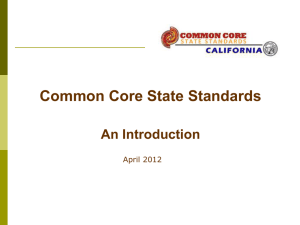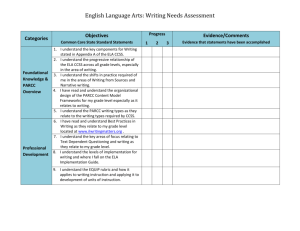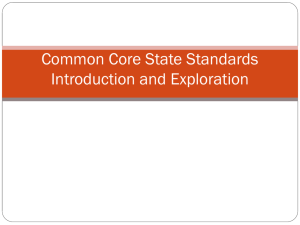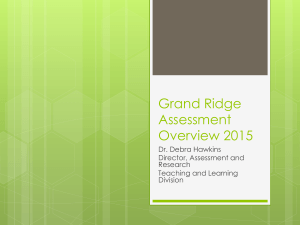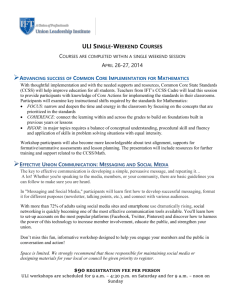File - CSLA SR Spring Workshop 2013
advertisement
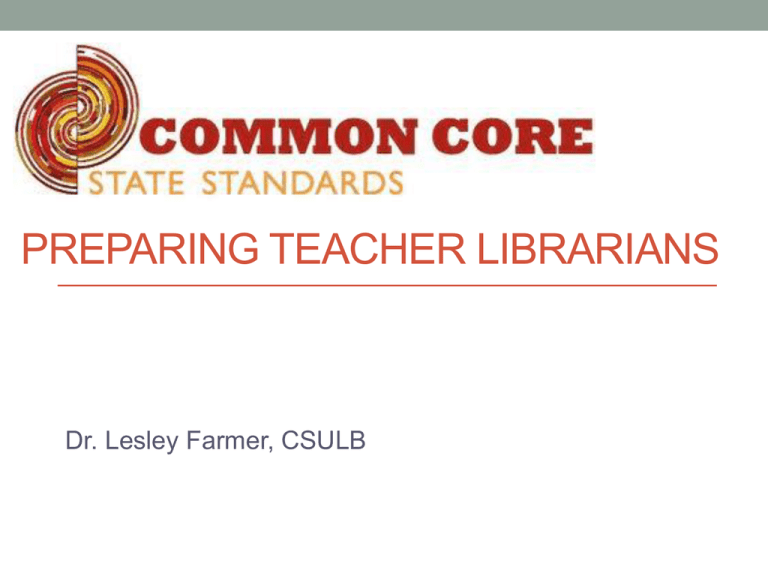
PREPARING TEACHER LIBRARIANS Dr. Lesley Farmer, CSULB Goals for today: • To look at the CCSS as a profession, with an eye to preparing teacher librarians • To develop TL awareness and understanding of this policy and its wider contexts • To hear from colleagues about how this may play out for TLs and other teachers • To consider implications for our own programs and interactions with school communities Ed Administrators Finances Language Development Resources Curriculum Development Social Studies Education Librarianship Early Childhood Arts Education PE and Health Science Education Reading & Lang Arts Math Education Social & Cultural Context School Counseling Families Ed Psych School Psych Ed Tech What do we already know about CCSS? • Place yourself on the continuum, from Very knowledgeable to Not knowledgeable at all… • How are we distributed along this continuum? • Comments, reflections… CCSS development and adoption • Developed in 2009 through an initiative of the Council of Chief State School Officers (CCSSO) as a way to: • Raise standards • Respond to “Race to the Top” • Developed by stakeholders, but not principally research- based • Adopted in 2010 by California’s State Board of Education • English Language Arts (ELA) and enhancing History/Social Science, Science • Mathematics • Other standards remain in place Focus • What do students need to know or understand and be able to do to be College and Career Ready by the end of grade 12? • Too many now take remediation • Need for flexible understandings to be ready for careers • A staircase to readiness – the most important improvement • Common across the states, with local flexibility and implementation Rationale for Common Core Preparation: The standards are college- and career-ready. Competition: The standards are internationally benchmarked. Common standards will help ensure our students are globally competitive. Equity: Expectations are consistent for all – and not dependent on a student’s zip code. Clarity: The standards are focused, coherent, and clear. Clearer standards help students (and parents and teachers) understand what is expected of them. Collaboration: The standards create a foundation to work collaboratively across states and districts, pooling resources and expertise, to create curricular tools, professional development, common assessments and other materials. Nationally… • The first effort to align standards across states • To date, the CCSS have been adopted by 45 states and 3 territories. • …all the states except Alaska, Nebraska, Virginia, Minnesota, and Texas. • Implementation of Common Core aligns with current work by CCSSO and NGA and NCATE/CAEP to enhance educator effectiveness • Response to Race to the Top, initiated by states California’s timeline • Fall 2012: • CTC aligning TPEs to Common Core • ELD Standards • Assessment Transition Plan due to Legislature • Spring 2013 • List of supplemental materials available • Pilot testing of summative assessments • Fall 2013 • Revised Framework for Mathematics • Spring 2014 • Revised Framework for ELA • Field testing of summative assessments • Spring 2015 • Administer operational summative assessments • 2016: • new cycle of curriculum adoptions begins 2012-2013 Fall CDE/SBE Activity Revised ELD standards adopted* (September/November-projected) Revised CTE Model Curriculum Standards adopted* (Septemberprojected LEA Activity Support ongoing professional learning to promote transition to the CCSS based upon priorities established in local plan Suggested Areas of focus: Mathematics: the standards for mathematical practice ELA: text complexity, text-based questions and tasks Assessment transition plan presented to the Legislature (November) General: develop structures for interdepartmental collaboration to improve student literacy across the content areas, revised CTE Model Curriculum Standards Continue to assess existing instructional materials and supplement them with resources from the library, internet, and primary source documents to develop CCSS-aligned lessons Revise existing quizzes, unit exams, and end-of-course exams to assess higher-level thinking, constructed responses, synthesis, and collaboration as indicated in the CCSS List of recommended supplemental instructional materials posted online* (February-projected) Plan and deliver professional learning opportunities for all components of the assessment system Spring Pilot testing of SBAC summative and interim assessments Generate and implement a “Formative Practices Plan” which includes Learning Targets, Criteria for Success, Collecting Evidence, and Documenting Evidence Summer 8-10 professional learning modules released (September) Review new professional learning modules from the CDE and incorporate new strategies into unit/lesson plans for 2013-2014 Begin implementation of technology plan Winter Review and utilize the CDE’s supplemental instructional materials list to supplement existing instructional materials 2013-2014 Fall CDE/SBE Activity Mathematics curriculum framework released* (November) LEA Activity Support ongoing professional learning to promote transition to the CCSS based upon priorities established in local plan Winter Spring Summer Promote mathematics curriculum framework Suggested Areas of focus: Mathematics: modeling ELA: collaborative conversations General: revised ELD standards, effective utilization of technology and media Utilize the mathematics curriculum framework as a blueprint for implementation of the mathematics CCSS Promote local awareness of the assessment transition plan, SBAC assessments, and purposes of assessment Revisit end-of-chapter/unit questions and quizzes in existing materials and elevate them to higher level critical thinking Include performance task assessments for end of unit/chapter assessment For mathematics, utilize word problems to provide students with opportunities to apply mathematical reasoning to real-world challenges Promote awareness of the new ELA curriculum framework and utilize in professional learning opportunities as appropriate ELA curriculum framework released* (May) Field testing of summative and interim assessments Promote ELA curriculum framework Visit SBAC’s Web pages for information about summative and interim field tests Implement local technology plan Utilize the ELA curriculum framework as a blueprint for implementation of the ELA CCSS 2014-2015 Fall CDE/SBE Activity Winter Spring Summer Provide professional learning opportunities and technical assistance to support full implementation of the CCSS based upon needs assessment Operational summative assessment administered 2015+ LEA Activity Provide professional learning to support full implementation of the CCSS Suggested areas of focus: Mathematics: support content shifts in K-8 ELA: writing informational text General: transition to SBAC assessments Ensure that technology is in place to administer SBAC assessments Debrief with staff and students all elements of the SBAC summative assessment Using feedback from debriefing, start planning adjustments to instruction and curriculum, formative practices, site-based assessments, expectations, learning goals, student/parent involvement, and all stakeholders’ role for improvement next year Create site-based plan for professional learning to ensure continuous improvement of instruction and a higher level of academic achievement for all students CDE/SBE Activity Provide professional learning opportunities and technical assistance to support full implementation of the CCSS based upon needs assessment Instructional materials adoptions* (math 2016, ELA 2018) LEA Activity Implement site-based plan with regular progress monitoring and reflection CISC Training Sequence BIG SHIFTS KEY ADVANCES -Informational Text -Literacy Standards -Text Complexity -Argument -Collaborative Conversations -Integration of Media LESSON DESIGN & BEST PRACTICES MODELS / LEVELS OF THINKING MATERIAL SPECIFIC CONVERSATION -Pyramid of Learning -Rigor/Relevancy Model -Gradual Release 3/25/2013 Kenji Hakuta - CSU Long Beach Source: Kirst (2013) Implementation • School districts are already planning for and using the Common Core State Standards. • By the time students who are now entering our credential programs finish our programs, all of California’s K-12 schools will be implementing the CCSS. • Will all our teacher librarians be prepared to work in a Common Core environment? CCSS and Assessments • Two consortiums have been awarded Race to the Top grants to develop assessments for the CCSS. • The Partnership for the Assessment of Readiness for College and Careers (PARCC) • The SMARTER Balanced Assessment Consortium (SBAC) – California has joined this one Smarter Balanced Assessment Consortium • http://www.smarterbalanced.org/ • Assessments to be developed, implemented by 2014-15 • 21 governing states • Bev Young (CSU Chancellor’s Office) is Higher Ed representative on the Executive Committee • Accessibility is a key principle • Use of technology to deliver assessments Smarter Balanced Test Item Types • Multiple choice • Technology enabled and enhanced items (e.g., edit text, draw an object) • Constructed response: short answer and maybe show their work • Performance tasks: e.g., view document/file and answer questions Technology impact: What students need • Practice reading screen-based texts • Practice in digital writing • Practice in collaborative writing • Practice in working with informational texts (e.g., links) Technology infrastructure issues • Is content bandwidth-need? • How many students can tech serve concurrently? • What is the comfort level of students with technology? • How are access and equity addressed? • How does the school protect student privacy? • How does the school protect its physical assets? • What will be the library’s role?? CCSS Structure: • English Language Arts • With Literacy in History/ Social Studies, Science, and Technical Subjects • Mathematics • Grade Levels: • K-5 • 6-12 • Standards for other subjects remain in use 3/25/2013 Kenji Hakuta - CSU Long Beach Major Shifts in New Standards ELA • • Regular practice with complex text and its vocabulary Math • Building knowledge through content-rich informational texts • • Emphasis on reading, writing, and speaking that is grounded in evidence from the text • Science Provide opportunities • for student access to the different mathematical • (discourse) practices described in the CCSS Support mathematical discussions and use a variety of participation structures Focus on students’ mathematical reasoning, NOT on students’ flawed or developing language Developing and using models Constructing explanations (for science) and developing solutions (for engineering) • Engaging in argument from evidence • Obtaining, evaluating, and communicating information 3/25/2013 Kenji Hakuta - CSU Long Beach New Paradigm Content Discourse Text (complex text) Explanation Argumentation Purpose Typical structure of text Sentence structures ΔVocabulary practices Language Arts English Language Arts - Reading standards for Literature K-5 - Key Ideas and Details Craft and Structure Integration of Knowledge and Ideas Range of Reading and Level of Text Complexity - Writing Standards K-5 - Text types and purposes Production and Distribution of Writing Research to Build Present Knowledge Range of Writing - Speaking and Listening Standards K-5 - Comprehension and Collaboration - Presentation of Knowledge and Ideas - Language Standards K-5 - Conventions of Standard English - Knowledge of Language - Vocabulary Acquisition and Use • Reading Standards for Literacy in History Social Studies 6-12 • Reading Standards for Literacy in Science and Technical Subjects 6-12 • Key Ideas and Details • Craft and Structure • Integration of Knowledge and Ideas • Range of Reading and Level of Text Complexity • Writing Standards for Literacy in History Social Studies 6-12 • Writing Standards for Literacy in Science and Technical Subjects 6-12 • Text types and purposes • Production and Distribution of Writing • Research to Build and Present Knowledge • Range of Writing Key changes to ELA instruction • A “staircase” of text complexity • Reading of narrative and informational text • Close reading and analysis of texts • Linking reading and writing: Writing is the outgrowth of • • • • excellent reading Expanding the range of writing Use of evidence and primary sources to marshal an argument, inform, explain Literacy in content areas Emphasis on research to study a topic, solve problems 27 Overview of Text Complexity Reading Standards include over exemplar texts (stories and literature, poetry, and informational texts) that illustrate appropriate level of complexity by grade Text complexity is defined by: 1. Qualitative measures – levels of meaning, structure, language conventionality and clarity, and knowledge demands 2. Quantitative measures – readability and other scores of text complexity 3. Reader and Task – background knowledge of reader, motivation, interests, and complexity generated by tasks assigned Reader and Task Example of Grade-Level Progression in Reading 28 CCR Reading Standard 3: Analyze how and why individuals, events, and ideas develop and interact over the course of a text. Reading Standards for Literature Reading Standards for Informational Text Grade 3: Describe characters in a story (e.g., their traits, motivations, or feelings) and explain how their actions contribute to the sequence of events. Grade 3: Describe the relationships between a series of historical events, scientific ideas of concepts, or steps in technical procedures in a text, using language that pertains to time, sequence, and cause/effect. Grade 7: Analyze how particular elements of a story or drama interact (e.g., how setting shapes the characters or plot) Grade 7: Analyze the interactions between individuals, events, and ideas in a text (e.g., how ideas influence individuals or events, or how individuals influence ideas or events). Grades 11-12: Evaluate various explanations for characters’ actions or for events and determine which explanation best accords with textual evidence, acknowledging where the text leaves matters uncertain. Grades 11-12: Analyze a complex set of ideas or sequence of events and explain how specific individuals, ideas, or events interact and develop over the course of the text. 29 Overview of Writing Strand Writing • Expect students to compose arguments and opinions, informative/explanatory pieces, and narrative texts • Focus on the use of reason and evidence to substantiate an argument or claim • Emphasize ability to conduct research – short projects and sustained inquiry • Require students to incorporate technology as they create, refine, and collaborate on writing • Include student writing samples that illustrate the criteria required to meet the standards Mathematics • Standards for Mathematical Practice • NCTM • National Research Council • Standards for Mathematical Content Standards for mathematical practice 1.Make sense of problems and persevere in solving them. 2.Reason abstractly and quantitatively. 3.Construct viable arguments and critique the reasoning of others. 4.Model with mathematics. 5.Use appropriate tools strategically. 6.Attend to precision. 7.Look for and make use of structure. 8.Look for and express regularity in repeated reasoning. Standards for mathematical content • K-12 content listed out by grade • High School standards listed in conceptual categories, to portray a coherent view of high school mathematics. • Number and Quality • Algebra • Functions • Modeling • Geometry • Statistics and Probability Key changes to math instruction • A focus on fewer topics, in more depth • Coherence: introducing new topics from grade to grade, highlighting relationships between the standards • Skills (how), understanding (why), and application (where) • Emphasis on practice What the standards do NOT do: • Tell teachers how to teach • Define all that can and should be taught • Go beyond the core • Define interventions needed for students • Support ELL or students with special needs • Provide everything needed to be college and career ready A look at the CCSS themselves: • http://www.scoe.net/castandards/ Table Groups: 1. 2. 3. 4. 5. Select a grade level at your table Read the standards in ELA and Math for that grade level List some key verbs (retell, recount, compare & contrast…) Highlight the verbs that align with model school library standards Note what strikes you… Brief share-out Discussion: Preparing Teacher Librarians Learn more… • http://www.scoe.net/castandards/ • http://www.ccsso.org/Resources/Publications/Common_Core_State_Stan dards_Implementation_Tools_and_Resources.html • Harvard Education Letter: Nine ways CCSS will change • • • • classroom practice http://hepg.org/hel/article/543#home Smarter Balanced Consortium: www.smarterbalanced.org EduCore: http://educore.ascd.org/ CDE: http://www.cde.ca.gov/be/st/ss/index.asp Krashen and Ravitch



